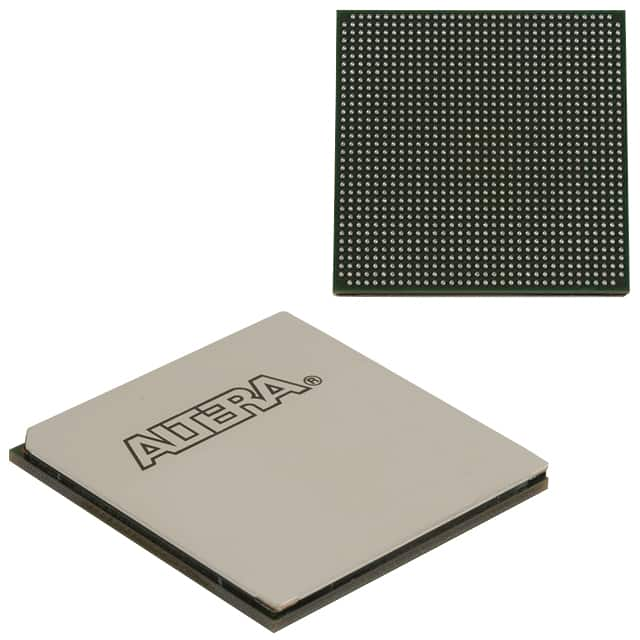EP4SGX360FF35C4
Product Overview
- Category: Field Programmable Gate Array (FPGA)
- Use: Digital logic design and implementation
- Characteristics:
- High-performance programmable logic device
- Offers high-speed processing capabilities
- Provides flexibility for custom designs
- Package: Flip-chip BGA package
- Essence: FPGA with advanced features and capabilities
- Packaging/Quantity: Available in trays or reels, quantity depends on customer requirements
Specifications
- Logic Elements: 360,000
- Embedded Memory: 1,638,400 bits
- Maximum User I/Os: 622
- Maximum User I/O Pins: 622
- Operating Voltage: 1.2V
- Speed Grade: -4
- Package Type: FBGA
- Package Pins: 1152
- Package Size: 35mm x 35mm
Detailed Pin Configuration
The EP4SGX360FF35C4 FPGA has a total of 1152 pins. The pin configuration is as follows:
- Pin 1: VCCINT
- Pin 2: GND
- Pin 3: VCCINT
- Pin 4: GND
- ...
- Pin 1152: VCCIO_2N
Functional Features
- High-performance FPGA with advanced architecture
- Supports various communication protocols
- Offers high-speed data processing capabilities
- Configurable logic elements for custom designs
- Integrated memory blocks for efficient data storage
- Flexible I/O options for interfacing with external devices
Advantages and Disadvantages
Advantages: - High-performance and speed - Flexibility for custom designs - Support for various communication protocols - Efficient use of resources - Integrated memory blocks
Disadvantages: - Higher power consumption compared to other solutions - Steeper learning curve for beginners - Higher cost compared to traditional logic design methods
Working Principles
The EP4SGX360FF35C4 FPGA works based on the principle of reconfigurable digital logic. It consists of configurable logic elements, memory blocks, and I/O interfaces. The device can be programmed to implement various digital logic functions by configuring the interconnections between logic elements. The configuration is stored in the internal memory and can be modified as needed.
Detailed Application Field Plans
The EP4SGX360FF35C4 FPGA finds applications in various fields, including: 1. Telecommunications: Used in high-speed data processing and communication systems. 2. Aerospace and Defense: Employed in radar systems, signal processing, and encryption. 3. Industrial Automation: Utilized for control systems, robotics, and machine vision. 4. Medical Devices: Integrated into medical imaging systems and diagnostic equipment. 5. Automotive: Used in advanced driver assistance systems (ADAS) and infotainment systems.
Detailed and Complete Alternative Models
- EP4SGX230FF35C4: Similar features but with a lower logic element count.
- EP4SGX530FF35C4: Higher logic element count for more complex designs.
- EP4SGX180FF35C4: Lower power consumption variant with reduced performance.
These alternative models offer different trade-offs in terms of logic capacity, power consumption, and cost, allowing users to choose the most suitable option for their specific requirements.
Word Count: 515
Lista 10 Vanliga frågor och svar relaterade till tillämpningen av EP4SGX360FF35C4 i tekniska lösningar
Sure! Here are 10 common questions and answers related to the application of EP4SGX360FF35C4 in technical solutions:
Q: What is EP4SGX360FF35C4? A: EP4SGX360FF35C4 is a specific model of Field-Programmable Gate Array (FPGA) manufactured by Intel.
Q: What are the key features of EP4SGX360FF35C4? A: Some key features of EP4SGX360FF35C4 include high logic density, high-speed transceivers, embedded memory blocks, and support for various communication protocols.
Q: In what applications can EP4SGX360FF35C4 be used? A: EP4SGX360FF35C4 can be used in a wide range of applications such as telecommunications, networking, video processing, industrial automation, and high-performance computing.
Q: How does EP4SGX360FF35C4 benefit technical solutions? A: EP4SGX360FF35C4 offers flexibility and reconfigurability, allowing developers to implement custom hardware accelerators, optimize algorithms, and achieve high performance in their technical solutions.
Q: Can EP4SGX360FF35C4 be programmed using industry-standard design tools? A: Yes, EP4SGX360FF35C4 can be programmed using popular design tools like Quartus Prime, which provide a user-friendly interface for designing and implementing FPGA-based solutions.
Q: Does EP4SGX360FF35C4 support high-speed data transfer? A: Yes, EP4SGX360FF35C4 includes high-speed transceivers that support various protocols like PCIe, Ethernet, and Serial RapidIO, enabling fast data transfer in technical solutions.
Q: Can EP4SGX360FF35C4 be used for real-time signal processing? A: Absolutely, EP4SGX360FF35C4's high logic density and embedded memory blocks make it suitable for real-time signal processing applications such as digital signal processing (DSP) and image/video processing.
Q: What is the power consumption of EP4SGX360FF35C4? A: The power consumption of EP4SGX360FF35C4 depends on the specific design and utilization. It is recommended to refer to the datasheet or use power estimation tools provided by Intel for accurate power analysis.
Q: Are there any development boards available for EP4SGX360FF35C4? A: Yes, Intel offers development boards like the Arria V GX Starter Kit that feature EP4SGX360FF35C4, allowing developers to prototype and test their designs before production.
Q: Where can I find more information about EP4SGX360FF35C4? A: You can find detailed information, documentation, reference designs, and support resources for EP4SGX360FF35C4 on Intel's official website or by contacting their customer support.


